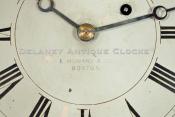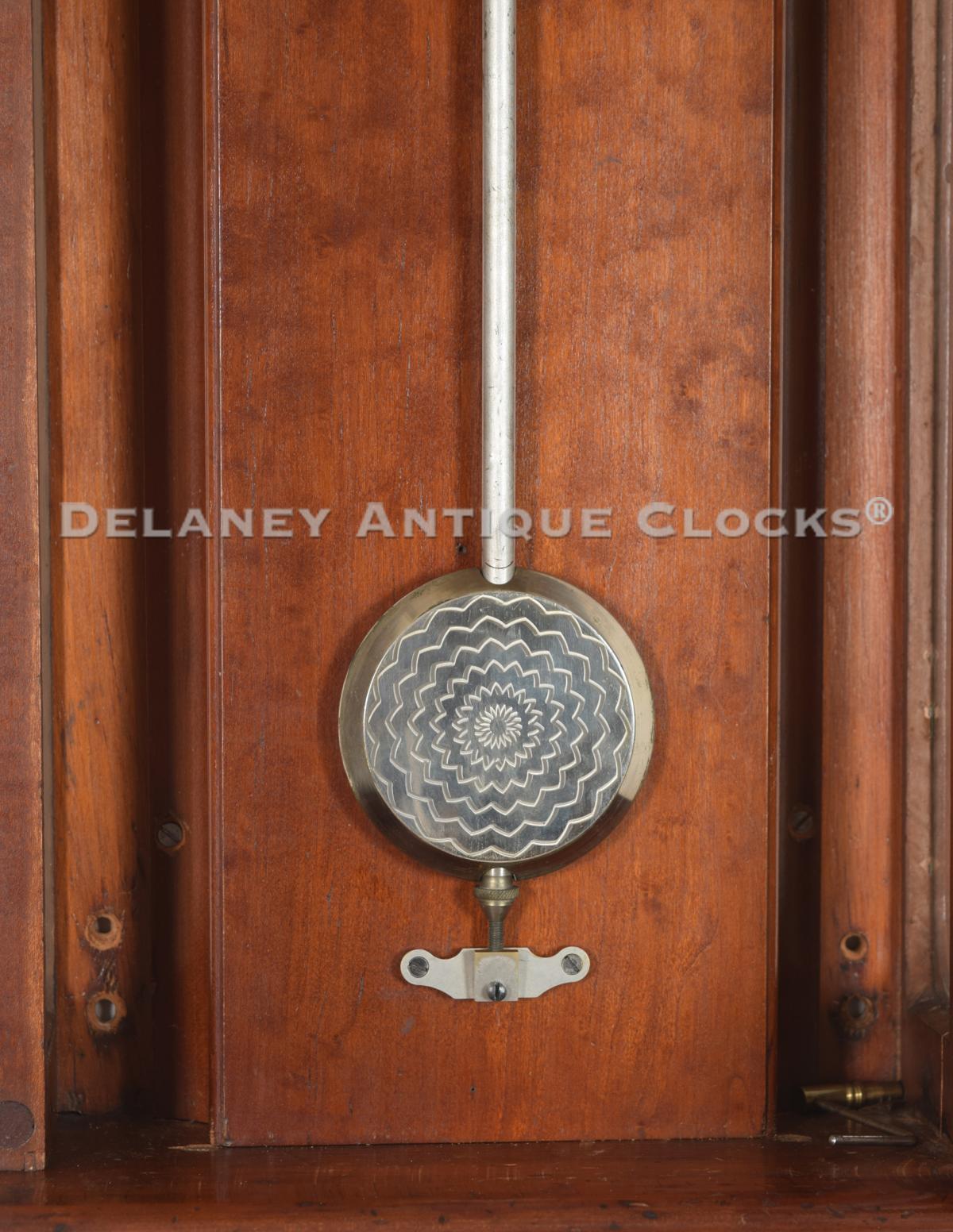E. Howard & Co., Model No. 59-8. A Howard "Vienna." 222083.
According to the E. Howard Clock catalog, four individual sizes of this model form were offered for sale. The largest size measured a full 70 inches in length and featured a 12-inch diameter dial. The smallest version of this clock is 36 inches long and features a 6-inch diameter dial. All four models could be constructed in oak, ash, cherry, or walnut wood. The first example of this form was made and sent to Howard's New York Office on May 15, 1874. The Howard Company had high expectations for this clock. They initially dubbed it "the new number 5." In truth, the production numbers were fairly low. Approximately 325 clocks were made. The last clock was built on 5/25/1898. In the 1880s, prices ranged from $25 to $60, respectively. Today, very few model 59s come to market on a bi-annual basis. This is a very good example of the form.
This example is the smaller of the two middle sizes measuring 48 inches in length. (The other middle size measures 56 inches long and has an 8-inch diameter dial.) The case wood is black walnut and features a modern surface that highlights the character and shading of the original finish underneath. This case design features six wooden finials. All are decoratively turned. The three lower finials are embellished with carvings. The front and sides of the case are fitted with glass panels. The side windows allow additional light into the interior of the case. The front door is also mostly glass. Through this, one can view the dial and the pendulum. The pendulum swings in front of the enclosed weight channel, which steps out from the back of the case. The pendulum tie-down is mounted to the bottom of this board.
The 8-inch diameter dial is painted on zinc. It is formatted with Roman-style hour numerals and a segmented minute ring. The Howard signature is formatted in block-style lettering. It reads, "E. HOWARD & CO. / BOSTON." Open moon hands display the time. " An ebonized wooden trim ring nicely frames the outer edge of this dial.
The weight-driven movement is brass and of very good quality. This clock is designed to run for eight days. The Maker's name and working location are die-stamped on the front plate. The pendulum rod extends from behind the dial. It is visible through the glass door. The rod is made of seasoned cherry and retains its original silver paint. It supports a 4.5-inch diameter bob. The bob is zinc. It is covered in brass and finished in nickel. It includes its original engine-turned design of concentric circles. This is in outstanding condition.
This fine example was made circa 1875.
Inventory Number 222083.
The E. Howard & Company succeeded the Howard & Davis firm in 1857. The Howard & Davis firm was comprised of Edward Howard and David Porter Davis and was established in 1842 in Roxbury, Massachusetts. Both men had just completed their clock apprenticeship under the guidance of Aaron Willard Jr in Boston. The Howard & Davis firm made high-grade clocks, precision balances, sewing machines, fire engines, and watches. After the dissolution of Howard & Davis, Edward Howard became Boston's leading manufacturer of weight-driven residential and commercial clocks. The firm also made a large number of tower clocks and watchman and salve clock systems. These sold well in the last quarter of the 1800s.
It has been said that the E. Howard Clock company never made an inexpensive clock, and everything they made was of very good quality. As a result, Howard clocks have become very collectible and are prized by their owners. Today, the E. Howard name enjoys outstanding name recognition.
For a more in-depth reading of Edward Howard and his various businesses, please read "Willard's Patent Time Pieces," written by Paul Foley.














